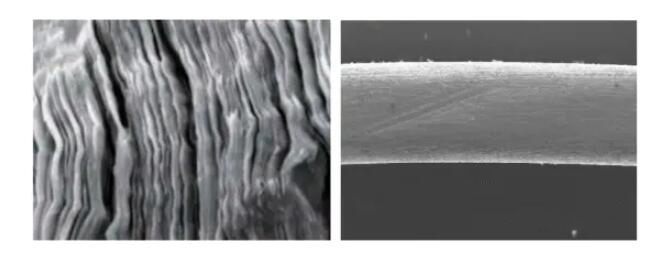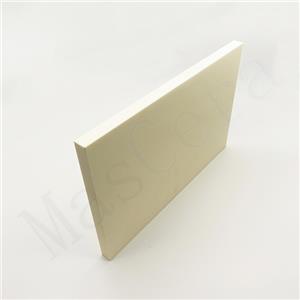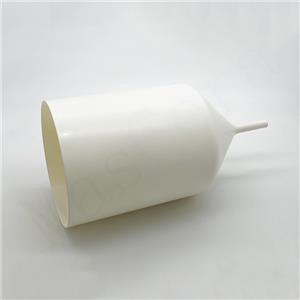Differences in Performance between Pyrolytic Boron Nitride and Hot-Pressed Boron Nitride
Boron nitride is a well-known advanced ceramic material with six crystal phases, the most common being cubic boron nitride (c-BN) and hexagonal boron nitride (h-BN). Among these, c-BN, similar to diamond, is mainly used for cutting tools, while h-BN, also known as white graphite due to its layered structure and lattice parameters resembling graphite, possesses excellent thermal conductivity and insulation properties, making it the most valued crystal phase.
However, even within the hexagonal crystal system of boron nitride, there are distinct variations based on different preparation techniques. One is boron nitride ceramic produced through high-temperature sintering processes such as pressureless sintering, hot-press sintering, and hot isostatic pressing sintering. Hot-press sintering is generally considered an ideal sintering method, yielding ceramics with high density, strength, and mature production processes, thus finding widespread applications. The other variation is pyrolytic boron nitride (PBN), prepared using chemical vapor deposition (CVD) techniques. Let's compare these two by focusing on hot-pressed boron nitride and pyrolytic boron nitride.
Hot-pressed boron nitride is a ceramic material made using hot-press sintering technology. The specific preparation process involves placing dried powder into specially designed graphite molds. The molds are then subjected to uniaxial or biaxial pressure while being heated within a certain temperature range to facilitate both shaping and sintering. This simultaneous heating and pressurization disrupts the layered structure of h-BN, promoting grain rearrangement and effectively lowering sintering temperature and time.
Hot-pressed boron nitride is an excellent electrical insulator with outstanding lubricity and high-temperature stability. It maintains its lubricating and inert properties even at extremely high temperatures. While its mechanical strength is relatively lower, it boasts high heat capacity, excellent thermal conductivity, exceptional dielectric strength, and ease of processing. Under inert atmospheres, boron nitride can withstand temperatures exceeding 2000°C, making it an ideal material for high-temperature heat insulation.
Moreover, hot-pressed boron nitride exhibits anisotropic characteristics. When atomic arrangement is perpendicular to the direction of pressure, strong bonds form, resulting in superior strength, thermal, and electrical properties. Conversely, atomic alignment parallel to the pressure direction forms weak bonds, leading to excellent lubricity. Leveraging these properties and its chemical stability, boron nitride ceramics are used for various applications such as crucibles for melting evaporated metals, boats, liquid metal transfer tubes, crucibles for synthesizing GaAs crystals, rocket nozzles, high-power device substrates, molten metal pipelines, pump components, cast steel molds, and insulation materials.
2. Pyrolytic Boron Nitride (PBN)
The preparation process of PBN differs significantly from that of hot-pressed boron nitride. PBN is produced using chemical vapor deposition (CVD) technology under high-temperature, high-vacuum conditions. It involves the chemical vapor deposition of ammonia and boron halides to form PBN materials, which can be deposited as thin plates or directly as final products such as tubes, rings, or thin-walled containers.
PBN prepared through high-temperature pyrolytic reactions boasts high purity, high thermal conductivity, mechanical strength, good electrical insulation, chemical inertness, excellent structure, and performance. This makes it an ideal container for element purification, compound and compound semiconductor crystal growth. PBN has various applications including OLED evaporation units, semiconductor single crystal growth (VGF, LEC) crucibles, molecular beam epitaxy (MBE) evaporating crucibles, MOCVD heaters, polycrystalline synthesis boats, high-temperature, high-vacuum equipment insulation boards, and more. However, PBN is more expensive due to slow deposition rates, rendering PBN products relatively costly.
Although both hexagonal boron nitride variants share common applications like evaporation crucibles, melting crucibles, and insulation boards, their performance differences still lead to distinctions in actual use. For instance, PBN products typically have total impurities of less than 100 ppm, ensuring purity above 99.99%. This high purity makes PBN crucibles more favored by the semiconductor industry and suitable for applications such as OLED evaporation units and semiconductor single crystal growth (VGF, LEC) crucibles. PBN's high density and purity also make it extensively used in vacuum processes, including high-temperature, high-vacuum equipment insulation boards.
It's worth noting that CVD processes impart nearly perfect layered structures to PBN, resulting in anisotropic thermal conductivity with a roughly 20-fold difference between the deposition direction (a-axis) and perpendicular to the deposition plane (C-axis). This property makes PBN an ideal material for crystal growth crucibles, such as in the field of GaAs crystal growth.
However, cost considerations also come into play for certain applications. For example, in metal melting applications, although PBN crucibles have high density and are pore-free, which makes it difficult for molten metal to penetrate the crucible walls, they are expensive. Thus, even though using PBN crucibles might yield better results, industrial production might not always justify the luxury due to the high cost.

Additionally, hot-pressed boron nitride also has its advantages. It is easier to process and shape according to requirements, making it more cost-effective for components like high-temperature furnace insulation parts, thermocouple protection tubes, crucibles or molds for melting metals, amorphous ribbon nozzles, and metal powder atomization nozzles for high-temperature applications. Moreover, recent advancements in the production process of hot-pressed boron nitride ceramics have allowed some of them to replace PBN, albeit with the crucial prerequisite of controlling impurity content, especially oxygen, silicon, and aluminum content in the powder material. In conclusion, pyrolytic boron nitride and hot-pressed boron nitride each have their own advantages, and the choice should be based on specific requirements in applications.
XIAMEN MASCERA TECHNOLOGY CO., LTD. is a reputable and reliable supplier specializing in manufacturing and sales of technical ceramic parts. We provide custom production and high precision machining for a wide series of high performance ceramic materials including alumina ceramic, zirconia ceramic, silicon nitride, silicon carbide, boron nitride, aluminum nitride and machinable glass ceramic. Currently, our ceramic parts can be found in many industries like mechanical, chemical, medical, semiconductor, vehicle, electronic, metallurgy etc. Our mission is to provide the best quality ceramic parts for global users and it is a big pleasure to see our ceramic parts work efficiently in customers' specific applications. We can cooperate on both prototype and mass production, welcome to contact us if you have demands.




